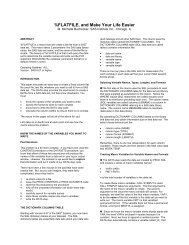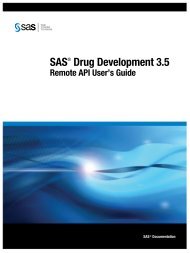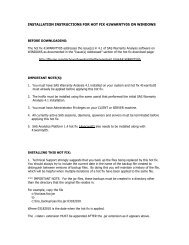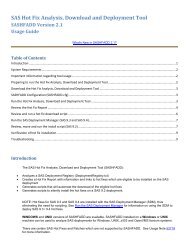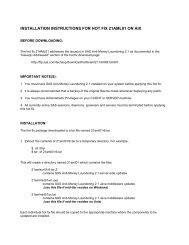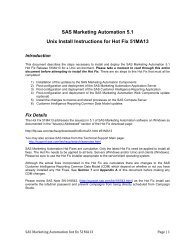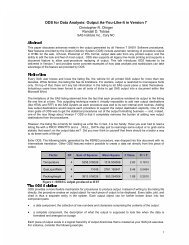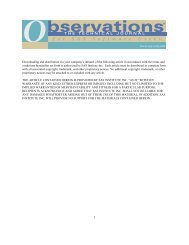SAS 9.3 Web Applications: Clustering - Index of - SAS
SAS 9.3 Web Applications: Clustering - Index of - SAS
SAS 9.3 Web Applications: Clustering - Index of - SAS
You also want an ePaper? Increase the reach of your titles
YUMPU automatically turns print PDFs into web optimized ePapers that Google loves.
14 Chapter 2 / Common Pre-Configuration Tasks<br />
Access to Configuration Files for <strong>SAS</strong> <strong>Web</strong><br />
<strong>Applications</strong> on Multiple Machines<br />
Configure Logging<br />
If you plan to configure a cluster on multiple machines, then copy the following<br />
directories (files and subdirectories) to each additional machine in the cluster. Use<br />
the same directory paths on all the machines:<br />
n <strong>SAS</strong>-config-dir/Lev1/<strong>Web</strong>/<strong>Applications</strong><br />
n <strong>SAS</strong>-config-dir/Lev1/<strong>Web</strong>/Common<br />
n <strong>SAS</strong>-config-dir/Lev1/<strong>Web</strong>/Temp<br />
n <strong>SAS</strong>-config-dir/Lev1/<strong>Web</strong>/Utilities<br />
n The directories needed by <strong>SAS</strong> Content Server should already be copied to the<br />
additional machines. These are named similar to <strong>SAS</strong>-config-dir/Lev1/<br />
AppData/<strong>SAS</strong>ContentServer/<strong>SAS</strong>Server2.<br />
Most <strong>of</strong> the <strong>SAS</strong> <strong>Web</strong> applications use log4j for logging. The logging location for<br />
each application is controlled with log4j configuration files in the <strong>SAS</strong>-config-dir/<br />
Levn/<strong>Web</strong>/Common/LogConfig. The default configuration for each application<br />
includes some type <strong>of</strong> file appender. The file appender identifies a single pathname<br />
for each <strong>SAS</strong> <strong>Web</strong> application. As a result, when multiple instances <strong>of</strong> each<br />
application open a log file, each instance attempts to open an identical pathname.<br />
This causes resource contention for vertical clusters. The following task describes<br />
how to modify the log4j configuration file to use the unique server identity. This<br />
resolves the resource contention for vertical clusters, but is also useful for horizontal<br />
clusters if the log files are written to shared storage, or if they are aggregated to a<br />
central location. Later steps describe adding the unique server identity as a JVM<br />
option for each <strong>Web</strong> application server instance.<br />
Follow these steps:<br />
1 Navigate to the <strong>SAS</strong>-config-dir/Levn/<strong>Web</strong>/Common/LogConfig directory.<br />
2 Edit each <strong>of</strong> the log4j configuration files, and add the<br />
${sas.appserver.instance.id} parameter as shown in the following example:<br />
<br />
<br />
<br />





